Menus
- The lively character remains unchanged
- Twin with a familiar character
- New standard tires
- Price increases by 300 euros
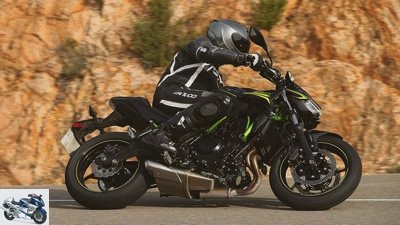
Kawasaki
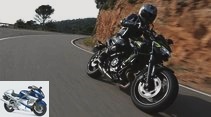
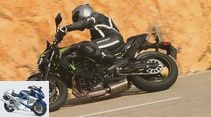
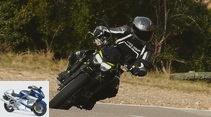
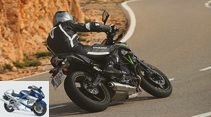
10 photos
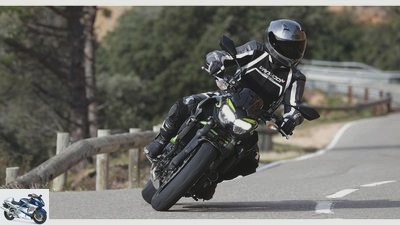
Kawasaki
1/10
Kawasaki has revised the Z 650. We have already been able to drive them in Spain.
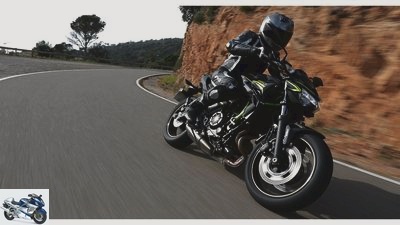
Kawasaki
2/10
The Twin was designed for the upcoming Euro 5 standard, but that does not change its lively character.
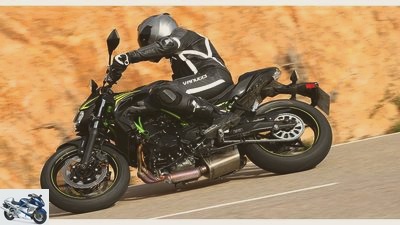
Kawasaki
3/10
He really perks up from 6,000 tours, at 10,000 rpm is limited.
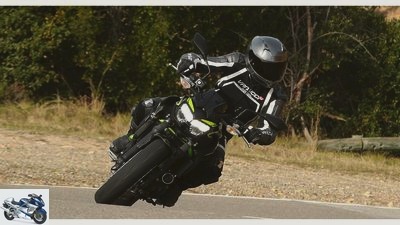
Kawasaki
4/10
He is lively, easy to turn and the spontaneous throttle response guarantees driving pleasure.
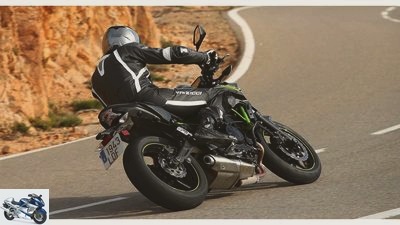
Kawasaki
5/10
The chassis was taken over unchanged, but there were new initial tires.
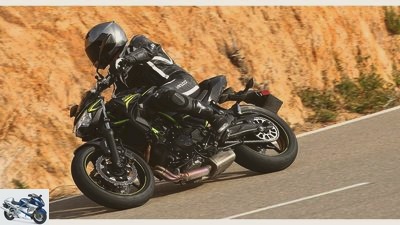
Kawasaki
6/10
Once the Dunlop Sportmax Roadsmart 2 is brought up to temperature, the grip is okay and they allow a brisk pace and plenty of lean angle.
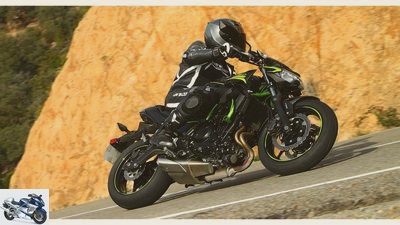
Kawasaki
7/10
With moderate damping rates, the set-up is optimized for lighter drivers.
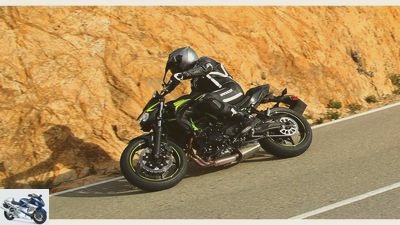
Kawasaki
8/10
At least among adult Central Europeans it reaches its limits when driving quickly and starts pumping.
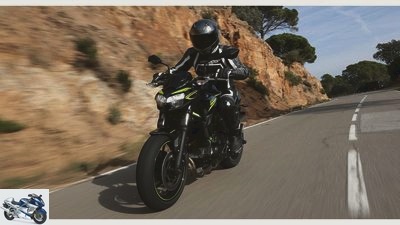
Kawasaki
9/10
If the 790 mm seat height bends your knees too badly, there is a 30 mm higher cushion available for an extra charge.
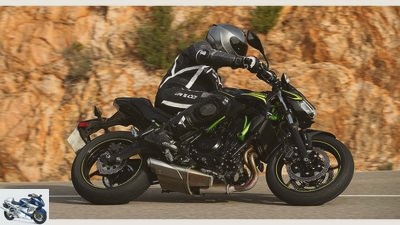
Kawasaki
10/10
The surcharge for the old model is moderate at 300 euros.
Kawasaki Z 650 driving report
The lively character remains unchanged
The Kawasaki Z 650 is the second best horse in the Kawa stable after the Z 900 in this country. It cannot be said that it urgently needed a revision. The Greens did it anyway. We were already able to drive the refreshed Z 650.
The most obvious changes to the Kawasaki Z 650 are the TFT cockpit (with smartphone connection) and the LED headlights. Both are identical to the big sister Z 900. Less obvious, but essential for the future are various changes in the inlet and outlet area of the cylinder head. Together with the modified airbox and a significantly larger catalytic converter on the exhaust pipe that is otherwise unchanged from the outside, the drive is now “Euro 5 ready”. It is currently homologated according to Euro 4.
Twin with a familiar character
On paper, the peak output remained the same at 50 kW (68 hp) at 9,000 rpm, while the maximum torque fell slightly from 66 Nm at 6,500 rpm to 64 Nm at 6,700 rpm. Nevertheless, there should be more meat on the bone in the middle speed range than before. However, the measures have not changed anything in the basic character of the twin. He is lively, easy to turn and delights with spontaneous throttle response. From about 3,500 rpm he can endure the six without a murmur, but is not averse to the upper third either. From 6,000 rpm, it really perks up. At 9,000 rpm, the orange flashing speed bar reminds you to change gear soon, at 10,000 rpm the limiter engages. Nevertheless, it can also be economical: Kawasaki states a consumption of 4.3 liters.
New standard tires
In contrast to the engine, the chassis remained unchanged except for the rear spring preload. With moderate damping rates, the set-up is optimized for lighter drivers. At least among adult Central Europeans it reaches its limits when driving quickly and starts pumping. The speedy ride, on the other hand, is enjoyed by the new Dunlop Sportmax Roadsmart 2, which has cast wheels instead of the D 215 from the same company. With cool, deep double-digit temperatures on partially damp roads with a salt surface and many photo-related breaks, they could not really convince. Little feeling for the existing grip and occasional slides, which were announced early, did not result in the great confidence. But once brought up to temperature, the grip is okay and they allow a brisk pace and plenty of lean angle.
Kawasaki
A 30 mm higher bench costs 160.65 euros extra.
Price increases by 300 euros
In terms of equipment, joy and sorrow are close together. Both hand levers are adjustable. The exhaust is made entirely of stainless steel, but in one piece. So just changing the rear silencer is not. If the 790 mm seat height bends your knees too much, there is a 30 mm higher cushion for you. However, not optional, but for an additional 160.65 euros. Due to the lack of space, there is a main stand neither for money nor for good words, and luggage transport also requires a bit of creativity due to the lack of hooks. Even if the pillion seat has been padded a little more generously, it is only recommended for short distances. Or very small co-drivers.
But these little gimmicks have so far not stopped customers from buying. And hardly will in the future either. The surcharge for the old model is moderate at 300 euros. The green standard Zett costs 6,995 euros, the black one shown and the white one each cost a hundred more. You are almost immediately at the dealer.
Related articles
-
Honda Africa Twin Adventure Sports (2018) in the driving report
markus-jahn.com 21st photos markus-jahn.com 1/21 The new Honda CRF 1000 L Africa Twin Adventure Sports was presented as an anniversary model. The popular…
-
Manufacturer The 800cc naked bike from Kawasaki Driving report Kawasaki Z 800 Mission: Check out Kawasaki’s new Z 800. Crime scene: southern France….
-
Driving report: Harley-Davidson XL 883L SuperLow
Harley-Davidson Driving report: Harley-Davidson Harley-Davidson XL 883L SuperLow Dwarf uprising in the short-legged department: Harley presents the…
-
Kawasaki Z 650 in the driving report
Kawasaki 9 photos Kawasaki 1/9 Photo gallery: Kawasaki Z 650 in the driving report. Kawasaki 2/9 The diet worked: Compared to the ER-6n, the Z 650 has…
-
Ducati Hypermotard 939 SP in the PS driving report
Ducati 27 pictures Ducati 1/27 Ducati Hypermotard 939. Ducati 2/27 An oil cooler was implanted into the revised engine, which can be seen in the front of the …
-
Kawasaki Ninja 650 in the driving report
Kawasaki 19th photos Kawasaki 1/19 Kawasaki Ninja 650 Kawasaki 2/19 New steel swing arm that is 2.8 kilograms lighter than the counterpart of the old…
-
Yamaha YZF-R3 in the PS driving report
Yamaha 17 pictures Yamaha 1/17 The new Yamaha YZF-R3 completes the model range and closes the gap between the R 125 and the R6. Yamaha 2/17 …
-
Kawasaki 23 photos Kawasaki 1/23 170 kilograms and 39 hp – winding roads are really fun. Kawasaki 2/23 Smart rim rings (15 euros per wheel), fixed…
-
Driving report Penner-Kawasaki W 650 Big Bang
Penner-Kawasaki W 650 Big Bang in the driving report Parallel twin with a single cylinder character Convert a twin into a single cylinder?…
-
Driving report, Kawasaki ER-5 Kawasaki ER-5 The Kawasaki program lacked an uncomplicated, inexpensive motorcycle with a broad impact. The ER-5 seems to…